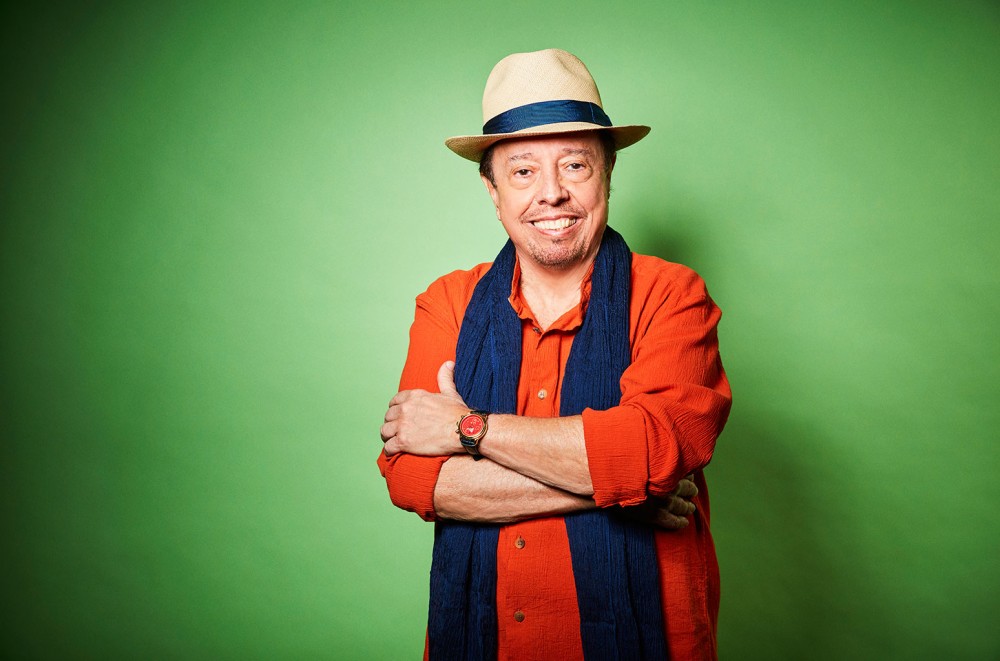
Sergio Mendes Talks New Album & Documentary ‘In the Key of Joy’
 59
59  60
60
A new album from Sergio Mendes recorded between arrives with a documentary about his life and career .
Sergio Mendes is known globally for his signature style of buoyant samba pop; his career that over more than half-a-century has also proved unsinkable. Mendes, who burst onto the scene with his instantly recognizable hit “Mas Que Nada” in the 1960s, and embraced new audiences with the same song reinterpreted with The Black Eyed Peas in the 2000s, has just turned 79.
His new album, In the Key of Joy, will be released on Feb. 28 through Concord Records. Recorded between Rio and Los Angeles, it features Common, Compton rapper Buddy and Colombian urban duo Cali y El Dandee, as well as Brazilian guitarist Guinga, famed jazz experimentalist Hermeto Pascoal and singer Gracinha Leporace (who is Mendes’ wife).
“I’m very curious and I love to learn,” Mendes tells Streets Talkin. “There’s always something fresh and new that I can mix with Brazilian music and make something different.”
Coinciding with the album comes a new documentary, also titled In the Key of Joy, directed by John Scheinfeld (Chasing Trane). It tells Mendes’ story, from his childhood in Niteroi, a city by the bay across from Rio, and his early days as pianist on the bossa nova scene in Copacabana to his first up-and-away years in Los Angeles with Atlantic and A&M records, his comeback to the top of the charts with The Black Eyed Peas and John Legend, and up to the making of his new album. Asked about his career, Mendes good naturedly chalks it all up to “serendipity.”
A deluxe edition of the In The Key of Joy album will include a second disc featuring Mendes classics heard in the doc, like “Pais Tropical,” “Primitivo” and his cover of Burt Bacharach’s “The Look of Love.”
During a phone conversation from his home in LA, where he has lived for almost 6 decades while continuing to represent Brazilian music throughout the world, Mendes spoke with Streets Talkin about the joy of working with young musicians, capturing the spirit of Brazil and looking back on his career.
Your new album and the documentary about your career share the title In the Key of Joy. Does that title sum up your approach to music?
I think music has that function, to bring joy to people. And Brazilian music has a lot of that.
When I think about Brazilian music the first words that would come to my mind would be joy, celebration, party… I think it is in the spirit of the people in general.
We’re going to have Carnival now in February, millions and millions of people in the streets celebrating, and the same thing happened on New Year’s Eve. So, it is a very celebratory culture. Problems are all over the world, and it always has been like that, and we have a lot of problems in Brazil. But when you see a little kid playing a drum on the street and dancing, that’s really the spirit of Brazil.
What was your concept for this album?
It took me two years to make. It’s the most time I’ve ever spent doing an album; I took my time doing songs, changing things, and just had a great time, a wonderful time, doing it. I decided I wanted to write a lot of the songs myself; the songwriter part of me went to the piano and started coming up with the melodies. The idea was not to do any covers like I’ve done in the past. It was something very fresh, very new, with guests from Brazil that I love like Hermeto [Pascoal], and then other guests from the United Stares like Common and Buddy. The record has the flavors of the diversity of Brazilian music; when you get a song from Hermeto and a song from Guinga or Carlinhos Brown, they represent what I really like in Brazil as far as songwriting and musicians.
You recorded in both Rio and L.A.?
I wrote most of the songs in here in my house in L.A. and then I went to Brazil. I recorded a lot of percussion in Brazil this time, which I love. Live percussion, not synthesized percussion. It’s a rich thing in Brazil, there are so many rhythms, so that is in the album. There’s a great percussionist named Pretinho Da Serrinha, he brought in his brother and his nephew, so that kind of percussion, you can only have it down there. I wanted to explore that past of Brazilian music and combine that with rap and with other styles. I love the diversity on this album.
Collaboration is a cornerstone of your career, whether in your earlier days with Antonio Carlos Jobim, Cannonball Adderley or Herb Alpert, or in recent years with will.i.am or John Legend. In the Key of Joy includes “La Noche Entera,” featuring Cali y El Dandee. Do you like reggaeton?
I do like it, yes. I tried to add Brazilian elements like the berimbau, the cuica, to put the Brazilian flavor into the beat. I wanted to do something in Spanish, I don’t think I’ve ever done anything in Spanish — I love the language and I love the rhythm, so I said, ‘I’d like to come up with a Brazilian reggaeton.’ Carlinhos Brown wrote most of the song. I met those kids, they’re from Colombia and they are brothers, they loved the song. I said, ‘let’s do it!’
I also did a song with a young Japanese rapper named Sky Hi. I go to Japan almost every year for the past 50 years. They really like my work, and I wanted to do something special for Japan this year. So I met this kid
and he wrote the lyrics in Japanese and did a rap on it. For Japan, there’s a bonus track with “Sabor Do Rio” in Japanese. I don’t know if it’s going to be released here.
“Sabor Do Rio” is the song you recorded with Common…
I called Common and he came and listened to the song, loved the song and brought his own performance to it — giving it that wonderful from Chicago to Rio de Janeiro flavor… Common knew my music and my work with John Legend and all of that.
There’s a fresh energy from the young people that I’ve met in my life since I met will.i.am. They all dig my music. They are wonderful people, and I love the diversity and variety they bring to it.
The release of this album coincides with the documentary by John Scheinfeld, and the album of that soundtrack, which not surprisingly opens with “Mas Que Nada.”
At the beginning, I was kind of hesitating [about doing the documentary.] It is such a personal thing. But when I met John, I liked him very much. He is very sensitive. I said, ‘OK, let’s do it!’ We went back to Brazil and interviewed a lot of my family and friends, and musicians, and that gave him a good perspective to talk about my career. I’m very happy with it. It was a good experience over all for me, revisiting my journey. Very good.


